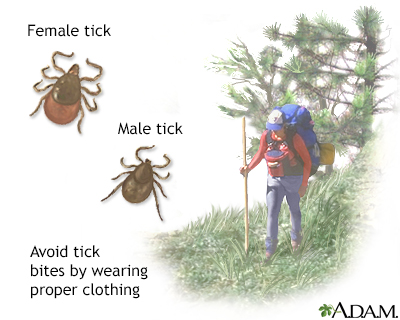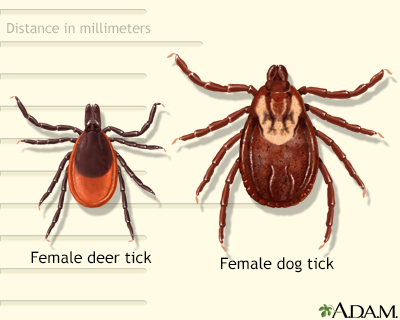Ehrlichiosis
Human monocytic ehrlichiosis; HME; Human granulocytic ehrlichiosis; HGE; Human granulocytic anaplasmosis; HGA
Ehrlichiosis is a bacterial infection transmitted by the bite of a tick.
Images



I Would Like to Learn About:
Causes
Ehrlichiosis is caused by bacteria that belong to the family called rickettsiae. Rickettsial bacteria cause a number of serious diseases worldwide, including Rocky Mountain spotted fever and typhus. All of these diseases are spread to humans by a tick, flea, or mite bite.
Scientists first described ehrlichiosis in 1990. There are two types of the disease in the United States:
- Human monocytic ehrlichiosis (HME) is caused by the rickettsial bacteria Ehrlichia chaffeensis.
- Human granulocytic ehrlichiosis (HGE) is also called human granulocytic anaplasmosis (HGA). It is caused by the rickettsial bacteria called Anaplasma phagocytophilum.
Ehrlichia bacteria can be carried by the:
- American dog tick
- Deer tick (Ixodes scapularis), which can also cause Lyme disease
- Lone Star tick
In the United States, HME is found mainly in the southern central states and the Southeast. HGE is found mainly in the Northeast and upper Midwest.
Risk factors for ehrlichiosis include:
- Living near an area with a lot of ticks
- Owning a pet that may bring a tick home
- Walking or playing in high grasses
Symptoms
The incubation period between the tick bite and when symptoms occur is about 7 to 14 days.
Symptoms may seem like the flu (influenza), and may include:
- Fever and chills
- Headache
- Muscle aches
- Nausea
Other possible symptoms:
- Diarrhea
- Fine pinhead-sized areas of bleeding into the skin (petechial rash)
- Flat red rash (maculopapular rash), which is uncommon
- General ill feeling (malaise)
A rash appears in fewer than one third of cases. Sometimes, the disease may be mistaken for Rocky Mountain spotted fever, if the rash is present. The symptoms are often mild, but people are sometimes sick enough to see a health care provider.
Exams and Tests
Your provider will do a physical exam and check your vital signs, including:
- Blood pressure
- Heart rate
- Temperature
Other tests include:
- Complete blood count (CBC)
- Granulocyte stain
- Indirect fluorescent antibody test
- Polymerase chain reaction (PCR) testing of blood sample
Treatment
Antibiotics (tetracycline or doxycycline) are used to treat the disease. Children should not take tetracycline by mouth until after all their permanent teeth have grown in, because it can permanently change the color of growing teeth. Doxycycline that is used for 2 weeks or less usually does not discolor a child's permanent teeth. Rifampin has also been used in people who cannot tolerate doxycycline.
Outlook (Prognosis)
Ehrlichiosis is rarely deadly. With antibiotics, people usually improve within 24 to 48 hours. Recovery may take up to 3 weeks.
Possible Complications
Untreated, this infection may lead to:
- Coma
- Death (rare)
- Kidney damage
- Lung damage
- Other organ damage
- Seizure
In rare cases, a tick bite can lead to more than one infection (co-infection). This is because ticks can carry more than one type of organism. Two such co-infections are:
- Lyme disease
- Babesiosis, a parasitic disease similar to malaria
When to Contact a Medical Professional
Contact your provider if you become sick after a recent tick bite or if you have been in areas where ticks are common. Be sure to tell your provider about the tick exposure.
Prevention
Ehrlichiosis is spread by tick bites. Measures should be taken to prevent tick bites, including:
- Wear long pants and long sleeves when walking through heavy brush, tall grass, and thickly wooded areas.
- Pull your socks over the outside of pants to prevent ticks from crawling up your leg.
- Keep your shirt tucked into your pants.
- Wear light-colored clothes so that ticks can be spotted easily.
- Spray your clothes with insect repellent.
- Check your clothes and skin often while in the woods.
After returning home:
- Remove your clothes. Look closely at all skin surfaces, including scalp. Ticks can quickly climb up the length of your body.
- Some ticks are large and easy to locate. Other ticks can be quite small, so carefully look at all black or brown spots on your skin.
- If possible, ask someone to help you examine your body for ticks.
- An adult should examine children carefully.
Studies suggest that a tick must be attached to your body for at least 24 hours to cause disease. Early removal may prevent infection.
If you are bitten by a tick, write down the date and time the bite happened. Bring this information, along with the tick (if possible), to your provider if you become sick.
Related Information
Tick biteRocky Mountain spotted fever
Typhus
Fever
Lyme disease
References
Dumler JS, Walker DH. Ehrlichia chaffeensis (human monocytotropic ehrlichiosis), Anaplasma phagocytophilum (human granulocytotropic anaplasmosis), and other anaplasmataceae. In: Bennett JE, Dolin R, Blaser MJ, eds. Mandell, Douglas, and Bennett's Principles and Practice of Infectious Diseases. 9th ed. Philadelphia, PA: Elsevier; 2020:chap 192.
Fournier PE, Raoult D. Rickettsial infections. In: Goldman L, Cooney KA, eds. Goldman-Cecil Medicine. 27th ed. Philadelphia, PA: Elsevier; 2024:chap 302.
BACK TO TOPReview Date: 8/26/2023
Reviewed By: Jatin M. Vyas, MD, PhD, Associate Professor in Medicine, Harvard Medical School; Associate in Medicine, Division of Infectious Disease, Department of Medicine, Massachusetts General Hospital, Boston, MA. Also reviewed by David C. Dugdale, MD, Medical Director, Brenda Conaway, Editorial Director, and the A.D.A.M. Editorial team.

Health Content Provider
06/01/2025
|
A.D.A.M., Inc. is accredited by URAC, for Health Content Provider (www.urac.org). URAC's accreditation program is an independent audit to verify that A.D.A.M. follows rigorous standards of quality and accountability. A.D.A.M. is among the first to achieve this important distinction for online health information and services. Learn more about A.D.A.M.'s editorial policy, editorial process and privacy policy. A.D.A.M. is also a founding member of Hi-Ethics. This site complied with the HONcode standard for trustworthy health information from 1995 to 2022, after which HON (Health On the Net, a not-for-profit organization that promoted transparent and reliable health information online) was discontinued. |
The information provided herein should not be used during any medical emergency or for the diagnosis or treatment of any medical condition. A licensed medical professional should be consulted for diagnosis and treatment of any and all medical conditions. Links to other sites are provided for information only -- they do not constitute endorsements of those other sites. © 1997- 2024 A.D.A.M., a business unit of Ebix, Inc. Any duplication or distribution of the information contained herein is strictly prohibited.
